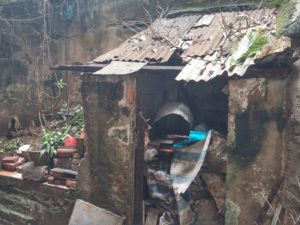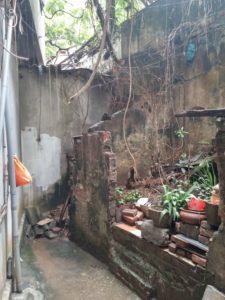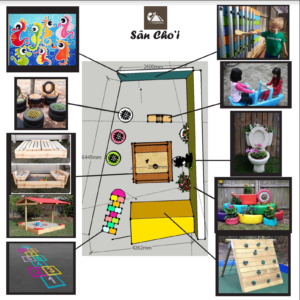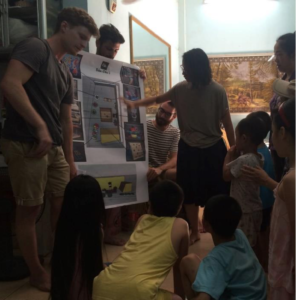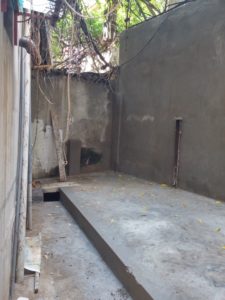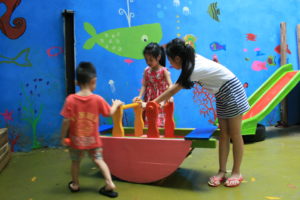The Management
What is the structure of Think Playgrounds and what are its plans?Vietnamese cities have experienced significant growth since the economic reforms (Đổi mới) launched by the state in 1986. This development has exerted a pressure on public spaces which were already ill-suited to the needs of children. It is in response to this problem that Think Playgrounds was created, following a softening of the state’s policies regarding civil society organizations. Through the use of do-it-yourself (DIY) urbanism, the organization aims to combat the lack of play spaces for children in Hanoi. In light of the initiative’s success, it is important for the practice of DIY urbanism, both in Vietnam as well as in the Global South, to understand how the organization emerged, how it operates on a day-to-day basis, and how it collaborates with other existing organizations.

Context
Vietnamese society has been marked by numerous phases, with the balance frequently oscillating between a strong state hierarchy on the one hand and more freedoms at the community level on the other. What most distinguishes the context in which Think Playgrounds emerged and operates is the particular balance between state control and state independence.
Civil Society in Vietnam
Civil society is a singular concept within the Vietnamese context, where the state is present at all levels and must approve all projects before they can move ahead. Civil society organizations are thus forced to interact by varying degrees with the public authorities, a situation which seems unorthodox within the Western conception of civil society. It’s therefore necessary to adopt a definition of civil society that’s based on the actors and their actions, and that understands that they behave independently of but not in opposition to the state, yet while not being free from state influence (Gray, 1999; Nørlund, 2007; Wischermann, 2010).
The Importance of Play for the Global South
Opportunities for play in early childhood contribute to the full cognitive development of children. Numerous longitudinal studies have demonstrated the positive effects of play on education, employment opportunities, salary and the reduction of violence (Berk and Meyers, 2013; Kellock, 2015; Walker et al, 2011).
The child’s development of self-management skills is among the key benefits that has been linked to play. These skills acquired through play are later found to be useful in their academic careers and life in society (Berk and Meyers, 2013; Kellock, 2015). These studies have largely been conducted in the Global North, however, and there are admittedly other major obstacles that help explain the poor educational attainment rates in Vietnam. Nonetheless, children’s play would seem to present an opportunity worth seizing for the Global South.
- Southeast Asia 66%
- North America 4%
Children at Risk of School Failure in Grade 4
(UNESCO, 2014; Kellock, 2015)
“People feel deep down like play is a fifth-tier issue, you know there is hunger, there is starvation. I don’t feel like that at all. There are 200 million children who live childhood without proper stimulation to develop their brain. That is a global massive issue that we need to deal with.”
Playground Ideas' Founder
Playgrounds in Hanoi
The downtown districts of Hanoi suffer from a lack of green spaces and of children’s playgrounds more especially. Those that do exist are prone to:
- Be neglected and underfinanced by authorities
- Have facilities that are low quality and in poor condition
- Be used as a storage area by nearby residents and businesses
- Be sold to developers by authorities in order to increase state revenues
- Be converted into government spaces (Nguyen, 2015)


*Hanoï Central Districts
(Reference: Nguyen, 2015)

Results & Discussion
The following sections aim to outline the observations made with regards to Think Playgrounds as an organization, and to describe the various strategies employed in its interactions with Vietnamese society, its volunteers, and its partners.
The Organization
The Goals of Think Playgrounds
Challenges
Social Enterprise
Technical Skills
Mission
The organization’s goal upon its creation in 2014 was to complete a low-cost children’s playground in close collaboration with the community. Since then, Think Playgrounds’ founders have established three core objectives for the organization: to create playgrounds throughout the city; to bolster the networks of actors working to improve conditions for children, the poor, and all of the city’s residents; and lastly, to support urban planners in the creation of children’s spaces. The founders view this latter objective as especially important, as urban planning authorities in Vietnam generally possess little notion of providing play spaces for children.

THINK PLAYGROUNDS FOUNDERS
Source: Duc Nguyen
Challenges
One of the problems encountered by the organization was the paucity of public spaces and the diverse needs of the population. The situation has produced a contest between different potential usages. Yet rather than lead to conflicts or confrontations, the contest over public space is resolved through informal modes of cohabitation that are often to the benefit of senior citizens, as revealed by a study of youth and public spaces in Hanoi. The challenge for Think Playgrounds is thus to negotiate a space for children, be it physical or temporal.
The organization aims to overcome this obstacle by raising awareness among different segments of society, but also by designing play structures for children that are moveable. This strategy allows for the spaces to be occupied by various activities in function of the time of day or week, thus facilitating a compromise between the needs of the sites’ diverse users. Nonetheless, negotiations remain difficult with the sites’ older users, as they want to keep these spaces for their own activities.
The other core challenge facing Think Playgrounds is a lack of capital. The founders state that it is difficult to find funding to build children’s spaces in Vietnam, as it’s rare to receive donations for design initiatives, and particularly for children’s playgrounds.
MULTIPLE USAGES TEMPLE
Source: Maxime Boutaghou-Courtemanche
“Old people want to keep the public space for themselve”
Think Playgrounds' FounderEXAMPLE OF MULTIPLE USAGES OF THE SPACE
The below photo depicts a performance that took place in a temple courtyard in Ba Dinh. This type of space is a sign of the strong demand for multipurpose public spaces in Hanoi. The temple shown below is used to host sports activities during the day and various community events in the evenings.
Social Enterprise
The not-for-profit organization operates like a social enterprise and is currently pursuing the associated legal status. Social enterprise status would grant them greater financial stability and the ability to expand, by allowing them to earn profit and amass capital while maintaining the tax advantages attendant to a social entity.
Think Playgrounds undertakes projects for private developers as well as for communities. The private projects, which are easier to execute, are what enable the proper functioning of the organization’s daily operations. While not being as socially oriented, the private installations nonetheless contribute to the overall supply of children’s playgrounds in Hanoi. In other words, while the creation of private spaces is not Think Playgrounds’ goal, it represents a necessary evil that corresponds minimally with their mission and ultimately enables them to carry out their community projects. The challenge for the founders is to find the balance between the different types of projects, in a context where the community projects demand greater time and involvement yet don’t allow them to cover their costs or contribute to the organization’s survival.
“Stay focus on the community projects.”
Think Playgrounds' FounderTechnical Skills
ACTION FOR THE CITY
ACCD is an NGO that’s devoted to improving the quality of life for residents of cities across Vietnam. The organization works to promote the concept of liveable cities, notably through community action, interventions in public spaces, and the creation of urban farms. ACCD supported Think Playgrounds in the stages prior, during and following the organization’s founding.
The founders of Think Playgrounds partnered with a master carpenter in order to complement their own skills training in architecture and communications. The 45 year-old carpenter worked previously in interior design, and when he got word of Think Playgrounds’ initiative, he decided to devote himself to it full-time. The woodworker’s interest for the project stems from the fact that he never played as a child and wants to ensure that other children are not similarly deprived. In addition to sharing his knowledge with Think Playground’s entire team of volunteers, the master carpenter of the studio also dedicates his weeks to training his apprentice.

Master Carpenter In Think Playgrounds’ Studio
Source: Maxime Boutaghou-Courtemanche
The mentor does not only carry out the designs, but influences them as well through his research into traditional games across Vietnam. He says that while the poor quality of materials available acts as a constraint, this does not prevent him from pursuing his research and applying it through the projects they implement. A project manager at Action for the City (ACCD), an NGO that is partnered with Think Playgrounds, points out that the use of these traditional games seems to be appreciated by older citizens, and thus serves to favour their inclusion. These installations might therefore represent a promising avenue for resolving the intergenerational tensions linked to the sharing of the spaces.
Profile
Satisfaction
Empowerment
Perception of Think Playgrounds
The Volunteers
Who are they?
♀ GENDER ♂
A certain gender parity was noted with interest among Think Playgrounds’ volunteers. It was more difficult, however, to identify the causes. Is it encouraged by the organization’s leadership team, which is itself gender-equal? Does it simply reflect the gender composition of the Vietnamese university classes from which they were recruited? Or rather, is it due to the combination of “physical” labour and a gendered separation of roles? As mentioned by one of the founders during an information session with the neighbourhood’s residents, Vietnamese men often consider children’s play to be the domain of women.
Depending on the season and projects under way, Think Playgrounds generally relies on a team of approximately twenty volunteers. Of the twenty, eleven participated in guided interviews. The average age of respondents was 22, and they were of diverse origins, with eight volunteers hailing from cities and regions outside the Hanoi metropolitan region. Only three respondents grew up in Hanoi, and one came from the outskirts of the capital. Many of the volunteers who originated from outside Hanoi had moved to the city to pursue their studies. Most of the volunteers we interviewed were studying architecture, with only two pursuing studies in other domains and two who were still in secondary school. The preponderance of architecture students among Think Playgrounds’ volunteers stems from their recruitment strategy that targets students in these programs. Nonetheless, only two of the respondents felt that Think Playgrounds’ actions related to architecture. The reasons for their involvement thus go beyond the desire to deepen their knowledge in their field of study.
Despite the fact that many respondents are studying architecture, for most of them Think Playgrounds represents their first experience of urban action projects. Nearly half of the respondents stated that they had been active in their communities prior to getting involved with Think Playgrounds, but only two of them had taken part in projects related to urban planning. For nine of the eleven respondents, therefore, their involvement represents their first experience of urban intervention. The organization thus provides Vietnamese youth with their first hands-on experience. The reasons for this involvement merit further exploration, as they could help us better grasp the mechanisms that might enable the creation of a DIY urbanism group in Hanoi, and also allow us to measure the potential effects of such a group on its members.
The respondents did not provide a specific amount of time in relation to the time devoted. Therefore their answers are here grouped into three categories. Individuals who devoted more than three days a week or who described their involvement with the organization as their primary occupation are here classified as full-time volunteers. All members of this group, however, are only full-time during their summer vacations, as their participation is reduced to weekends only or becomes more sporadic once they return to their studies. Respondents who devote three days a week or less to Think Playgrounds are here considered part-time volunteers. Lastly, there was one respondent who described his involvement as shifting in function of the needs of the organization.
Who Are They ?
%
ACT FOR THE FIRST TIME ON THE BUILT ENVIRONMENT (N=11)
YEARS OLD ON AVERAGE
- ARCHITECTURE 64%
- HIGH SCHOOL 18%
- COMPUTER SCIENCE 9%
- ECONOMY OR FINANCE 9%
FIELDS OF STUDIES (N=11)
- FULL-TIME DURING THE HOLIDAYS 64%
- PART-TIME 27%
- VARIES DEPENDING ON THINK PLAYGROUNDS’ NEEDS 9%
WEEKLY CONTRIBUTION (N=11)
Cities or Regions of Origin
Are They Satisfied?
When respondents were asked how they felt following their involvement with Think Playgrounds, the words “happy” and “fun” were the most recurrent. This evident satisfaction on the part of their volunteers is not surprising when we compare the organization’s model with best practices regarding volunteer satisfaction. The time allotted, the interpersonal relations, the trainings, and the results of their involvement are all elements we can invoke to explain this level of satisfaction.

Adaptation du modèle conceptuel de la chaîne de loyauté des bénévoles
(Wisner et al. 2005)
THE SOURCES AND IMPORTANCE OF VOLUNTEER SATISFACTION
The degree of involvement of volunteers, and especially their long-term participation, can be assessed by looking at the satisfaction that they derive from the activity. This approach becomes necessary when we consider that it is the satisfaction of volunteers that inspires their optimum involvement and thus contributes to the long-term success of the organization, but also that favours the expansion of the volunteer pool once they invite their friends to get involved (Wisner et al. 2005).
The literature suggests numerous principles that are conducive to the satisfaction of volunteers. Among these we find the flexibility of hours, the social nature of the activities, the sense of contributing to an important cause, and the belief that your contribution is having an impact (Costa et al. 2006; Ferreira et al., 2012; Green & Chalip, 2004; Wisner et al. 2005).
Flexibility
Think Playgrounds allows its volunteers the flexibility to decide when to come to the organization’s studio and for how long. Although certain projects or events require a more significant time commitment, volunteers are free to offer what they can rather than have the schedules determined by the organization. This freedom does not result in any lesser involvement, however, as the majority of volunteers devote a significant portion of their free time to Think Playgrounds.

PLAYGROUND CONSTRUCTION
Source: Maxime Boutaghou-Courtemanche
MORE ON FLEXIBILITY
Flexibility with regards to the time commitment and schedule is often essential to the satisfaction of volunteers. Volunteer work, by its nature, provides no monetary gain and is not necessarily tied to career or educational advancement. Volunteers therefore desire a certain degree of flexibility with their involvement. The ability for a volunteer to work as much, as little, and when they want is one of the keys to their satisfaction (Wisner et al. 2005).
The time that volunteers devote to Think Playgrounds is not linked to their fields of study. Students in economics or computer science devoted just as much, if not more, of their time than some students in architecture. It is therefore notable that Think Playgrounds is initiating students from traditionally unrelated disciplines into the domain of urban intervention. The involvement of students from outside the domain of urban planning is partly ascribable to the participants’ concern for child welfare, which was the most recurrent motivation invoked when volunteers were asked to explain their involvement.
Social Activity
The social nature of the time devoted to Think Playgrounds was an important factor for most of the volunteers. It is important to understand the work environment in which the activities of Think Playgrounds’ take place. Volunteers are free to work at their own pace in a friendly atmosphere where each is invited to create their own designs for the installations. The social nature of this involvement is all the more apparent when we consider that most of the volunteers arrive with their friends.

COLLECTIVE LUNCH AT THINK PLAYGROUNDS’ STUDIO
Source: Maxime Boutaghou-Courtemanche
MORE ON THE SOCIAL ASPECT
Regarding the motivations for the volunteers’ involvement, the desire to get out of their homes and participate in a social activity came second only to their concern for the well-being of children, and was tied with their desire to acquire new skills and combat children’s abusive use of video games.
When asked whether they invited their friends to participate in Think Playgrounds’ activities, eight of eleven respondents answered in the affirmative, with some stating that they regularly brought them to the organization’s studios.
Effectiveness
Think Playgrounds provides adequate training to their volunteers, which contributes to their sense of effectiveness. This feeling, in addition to contributing to their overall satisfaction, also increases their sense of empowerment, as seen by the confidence expressed by the majority of volunteers with regards to their ability to launch a similar initiative themselves.
VOLUNTEER IN THINK PLAYGROUNDS’ STUDIO
Source: Maxime Boutaghou-Courtemanche
MORE ON EFFECTIVENESS
For Green and Chalip, volunteers derive satisfaction from their sense of effectiveness, which is in turn enabled by trainings that equip volunteers with the required skills to fulfill their role (Green & Chalip, 2004).
When asked which skills they developed as a result of their involvement with Think Playgrounds, the majority of volunteers invoked either team work or technical skills related to carpentry. Very few raised a lack of technical skills when asked about the difficulties they encountered, and the few that did were able to surmount this obstacle with the help of team work.
Making a difference
The majority of respondents felt that their involvement with Think Playgrounds would produce concrete results. If we exclude those volunteers who were still engaged in their first project and thus hadn’t yet had the chance to observe the results of their work, we can state that the totality of respondents believed their involvement was having an impact.
- VOLUNTEERS CONSIDERING THEY ARE MAKING A DIFFERENCE (N=11) 82%
MORE ON CONTRIBUTING TO CAUSE
According to the literature, most volunteers do not participate in an activity to acquire skills, but rather because they ascribe to the organization’s mission and wish to feel that they are contributing to the fulfillment of that mission (Ferreira et al. 2012; Wisner et al. 2005).
Empowerment?
The vast majority of Think Playground’s volunteers would like to launch a similar initiative themselves. Many of them also believe that they possess or could obtain the required skills. The organization is therefore successful in its goal of contributing to the reinforcement and expansion of the network of actors in the domain of play through the capacity-building of its volunteers.
WOULD YOU LIKE TO LAUNCH A SIMILAR INITIATIVE?
WOULD YOU BE ABLE TO LAUNCH A SIMILAR INITIATIVE?
How Do They Perceive Think Playgrounds?
DIY Urbanism?
None of the volunteers were familiar with the concepts of DIY or tactical urbanism. Certain respondents, while not being familiar with these terms, nonetheless associated Think Playgrounds’ actions with the idea of encouraging parents and communities to get involved in improving their quality of life. Yet while their actions are not motivated by explicit adherence to the cause of DIY urbanism, the volunteers nonetheless describe their work in terms evocative of the movement.
Architecture?
The volunteers view their work as combining woodworking and elements of design, but don’t see it as relating to architecture. Rather than associating their projects with the creation of spaces or facilities, the volunteers believe they are contributing to changing mentalities related to play.
Against Technology?
Unsurprisingly, the volunteers at Think Playgrounds believe that there is a lack of children’s spaces in Hanoi. What surprises the most in their responses, rather, is the link they draw between this lack of space and what they deem to be the abusive use of technology and video games by children. The volunteers in fact ascribe the lack of children’s playgrounds to the tendency of children to stay at home playing video games. Their actions can thus be considered a direct response against what they view as a destructive habit.
“TPG just builds a part of playgrounds in Hanoi and gives a different look about playground to people. They support and guide the way to think : How should children play?”
Think Playgrounds' Volunteer
Project Implementation
During our research, we were invited to take part in the implementation of one of Think Playgrounds’ projects, namely the transformation into a playground of an old public washroom located at the end of an alleyway in a densely populated district. The timeline below outlines how the stages mentioned previously are carried out for a specific project.
Location of the Old Public Washroom transformed into a Playground
What Are the Implementation Phases of a Project?
The implementation phases of Think Playground’s community projects generally follow the precise order described below by the organization and its partners:
First contact with a client. The client initiates contact with Think Playgrounds either directly or
through one of its partners.
Field assessment to identify the needs on the ground, notably through questionnaires distributed to
future users.
Design of the structures for the playgrounds. This phase is undertaken by the founders and volunteers
at Think Playgrounds, with adjustments proposed subsequently by the master carpenter.
The community is presented with the proposed designs, which are then adapted in response to the
concerns and desires of the residents and partners.
Once the design is finalized and a cost assessment produced, the fundraising can begin. The various
partners contribute, but the bulk of funding is acquired through crowdfunding.
Construction of the installations by the volunteers at Think Playground’s studios and preparation of
the site.
Delivery of the completed site to the community. The maintenance of the structures and use of the
space are taken over by the residents or mass organizations such as the Vietnamese Youth.
The Network of Partners
Action for the City
Healthbridge
Playground Ideas
Our mission is to help anyone anywhere to build a playground
– Playground Ideas’ Founder
UN-habitat
How Do They Work Together?
Small Actions, Big Visions
“Playstreet … I really love and I think in terms of public perception of the idea, that is a fantastic way to use the topic and a very low risk. No one is goin to go : Oh look there’s a street full of fun stuff, what a bad idea. … it just subliminatarely pushes the idea that play is really important”
Playground Ideas' FounderThink Playgrounds relies on its partners’ influence to convince public actors to hold small-scale events aimed at increasing their media presence and raising public awareness around the lack of children’s spaces. In spite of its limited resources and without taking any major risks, the organization succeeded in sparking interest in its actions through its weekly and one-time installations. Through Playstreet and Playday, Think Playgrounds demonstrated the potential of tactical urbanism in Vietnamese cities.
PLAYSTREET AND PLAYDAY
Playstreet was one of Think Playground’s earliest initiatives. The weekly event took place on a pedestrianized street in a dense neighbourhood of old Hanoi, where temporary playgrounds were installed for the area’s children. The project was carried out with the support of Healthbridge and in close cooperation with the local authorities.
Playday, although similar, is an event organized by Think Playgrounds and its regular partners, but occasionally funded by corporate partners such as car companies or real estate developers. These events are sometimes held in more community-oriented spaces, but can also be organized on sites associated with economic development projects.
Playstreet et Playday are an important component of Think Playground’s operations, as they serve to demonstrate the public’s interest in playgrounds, as well as the possibility of creating low-budget spaces in harmony with the existing environment.
Protection & Negociation
“… we have worked pretty hard on our brand and we are perceived as this much bigger thing than we actually are… Therefore sometimes we can play a bit of a good cop, bad cop role so we can advocate. I’m happy to be the bad guy and so to say we need this much money we need it by this date and you need to stop screwing us around otherwise we just can’t do it (And then) our local partners can be the nice guys they can come in and say yeah we would like to open it, that works quite well. So you keep that grassroots collaborative attitude on site.”
Playground Ideas' FounderNetworking allows Think Playgrounds to maintain good relations with the local authorities and to avoid potential penalties. Their partnerships with NGOs like Healthbridge and ACCD allow them to disseminate information and raise awareness around the broader issues undergirding their actions. Meanwhile, the partnership with a foreign NGO like Playground Ideas allows them to delegate negotiations with authorities whenever projects stagnate or conflicts arise.
INTERNATIONAL COLLABORATION IN DA NANG
In 2016, Think Playground, Healthbridge and Playground Ideas submitted a joint proposal in response to a competition launched by Unresilient Cities in conjunction with the City of Da Nang. The Vietnamese organization visited the site and proposed a design in harmony with residents and the local environment, while the participation of Playground Ideas and Healthbridge provided them with technical assistance and conferred an international status to the proposal. Their proposal was successful, but local authorities wanted the bidding organizations to be responsible for their own fundraising. It’s in this type of situation where alliances with other organizations are particularly useful. Playground Ideas demanded that the local authorities be responsible for amassing the required funds. To date, however, the project has still not been implemented due to a lack of funding initiatives on the part of the Da Nang authorities.
Same Goals, Different Roles
“Healthbridge focuses on advocacy, but there is desire to have a pilot project to show how the ideas can work in reality : Make the case.”
Healthbridge's OfficerThink Playgrounds and its partners fulfill different but complementary roles aimed at improving living environments. Think Playgrounds are focused on action, experimenting and implementing projects designed to attract the attention of politicians and the public. Its partners are more focused on the promotion of interests, and benefit from the examples created by Think Playgrounds. They in turn support the Vietnamese organization’s arguments by sharing their work in their publications.
Knowledge Sharing
“… they cannot build playgrounds for the whole country, (they) need to adapt and share expertise. They adapted since we met them, they developed support nationally or internationally.”
Healthbridge's OfficerThink Playgrounds actively participates in the training of other Vietnamese groups and initiatives devoted to the promotion of children’s play. With the financial support of its partners, the organization shares its knowledge and strategies in order to increase the number of DIY interventions. This approach in turn allows it to grow its network and to further the cause of children’s play both in Vietnam and internationally.
TRAINING OF HUE STUDENTS
During the course of our research we observed a training session provided by Think Playgrounds to a group of students from Hue. The students had travelled with the support of a grant offered by ACCD in order to attend the training aimed at expanding the initiative beyond the Vietnamese capital.
In the training, the founders listen to the problems encountered by the youth and share their experiences and strategies, notably with regards to funding and community involvement. The master carpenter, for his part, teaches the students how to construct simple and modifiable modular structures in addition to general woodworking techniques.
How Do They View Think Playgrounds?
Leader of the Global South
Think Playground’s partners laud the innovative nature of the organization’s actions and approach. For the founder of Playground Ideas, the Vietnamese organization truly stands out through its political and marketing tactics. With a professional graphic signature and a keen grasp of the importance of bringing other actors onside through prominent events, Think Playgrounds has established itself as a key player within the DIY community of the Global South.
Conflicts Between Social Goals and Private Sponsorships
The services offered by company sponsors can enter into conflict with the goals of the organization and its partners. For example, the NGO partners found it problematic when Think Playgrounds associated with both a car manufacturer and an organization working to reduce the role of motor vehicles for one of its events. Illustrating the complexity of cooperating with NGOs while getting sponsored by private enterprise.
More Than Play
Think Playgrounds’ partners view the organization’s actions as contributing to wider issues beyond the simple right to play. Through its actions it helps further the quality of life in urban environments and promote citizen involvement, the environment, public health, and economic development through the cognitive development of children.
“I’m not stupid enough to think play is the only element, but it’s a powerful argument, you listen to that and you think: this is a big deal.”
Playground Ideas' FounderSitemap
The Politics
What are Think Playgrounds’ links with municipal authorities?
The Management
What is the structure of Think Playgrounds and what are its plans?
The Community
How are the projects received and what are their impacts on the communities ?
The Research Project
Brief presentation of the methodology of research, the limits, the biography, the research team, the key collaborators and the partners.
Recommendations
Recommandations made for Think Playgrounds, the district / neighbourhood / city officials, the civil society and other Global South DIY urban planing groups.
Media Gallery
Panorama, 360 view and photos of the studied sites.




